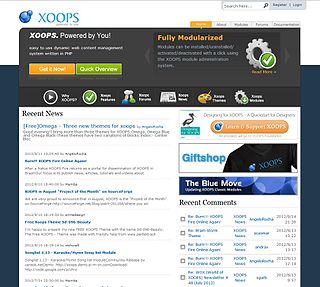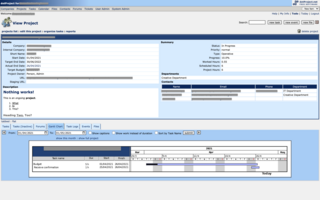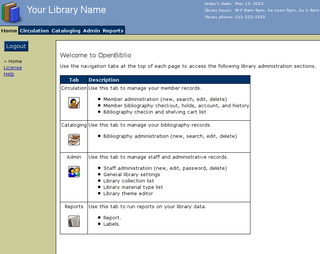
Drupal is a free and open-source web content management system (CMS) written in PHP and distributed under the GNU General Public License. Drupal provides an open-source back-end framework for at least 14% of the top 10,000 websites worldwide and 1.2% of the top 10 million websites—ranging from personal blogs to corporate, political, and government sites. Systems also use Drupal for knowledge management and for business collaboration.

Tiki Wiki CMS Groupware or simply Tiki, originally known as TikiWiki, is a free and open source Wiki-based content management system and online office suite written primarily in PHP and distributed under the GNU Lesser General Public License (LGPL-2.1-only) license. In addition to enabling websites and portals on the internet and on intranets and extranets, Tiki contains a number of collaboration features allowing it to operate as a Geospatial Content Management System (GeoCMS) and Groupware web application.

WebGUI is an open-source content management system written in Perl and released under the GNU General Public License.

XOOPS is a free open-source content management system (CMS), written in PHP. It uses a modular architecture allowing users to customize, update and theme their websites. XOOPS is released under the terms of the GNU General Public License (GPL) and is free to use, modify and redistribute.
The following tables compare general and technical information for a number of wiki software packages.
A web content management system is a software content management system (CMS) specifically for web content. It provides website authoring, collaboration, and administration tools that help users with little knowledge of web programming languages or markup languages create and manage website content. A WCMS provides the foundation for collaboration, providing users the ability to manage documents and output for multiple author editing and participation. Most systems use a content repository or a database to store page content, metadata, and other information assets the system needs.

DNN Platform is a web content management system and web application framework based on the .NET Framework. It is open source and part of the .Net Foundation.

dotProject is a web-based, multi-user, multi-language project management application. It is free and open source software, and is maintained by an open community of volunteer programmers.

Silverstripe CMS is a free and open source content management system (CMS) and framework for creating and maintaining websites and web applications. It provides an out of the box web-based administration panel that enables users to make modifications to parts of the website, which includes a WYSIWYG website editor. The core of the software is Silverstripe Framework, a PHP Web application framework.

EPESI BIM is a web based, cloud-native CRM/ERP application to store, organize, access and share business records. Manage your data precisely, flexibly and easily, simplifying internal communication and making work-flow more efficient. Epesi has been designed as a Kickstarter project and provides "no code" and "low code" environment for developers. Epesi is an open-source, PHP/Ajax framework for rapid development of web-based, database-driven single page applications. The framework includes the Epesi CRM multi-user application. It requires PHP 7.x and MySQL or PostgreSQL database server on the server-side and can be accessed using any modern browser. Epesi framework and Epesi CRM application are released under MIT license.

Exponent CMS is a free, open-source, open standards modular enterprise software framework and content management system (CMS) written in the programming language PHP.

NewGenLib is an integrated library management system developed by Verus Solutions Pvt Ltd. Domain expertise is provided by Kesavan Institute of Information and Knowledge Management in Hyderabad, India. NewGenLib version 1.0 was released in March 2005. On 9 January 2008, NewGenLib was declared free and open-source under GNU GPL. The latest version of NewGenLib is 3.1.1 released on 16 April 2015. Many libraries across the globe are using NewGenLib as their Primary integrated library management system as seen from the NewGenlib discussion forum.

ImpressCMS is an open source content management system for building and maintaining dynamic web sites, written in the PHP programming language and using a MySQL database. The product is released under the GNU General Public License version 2.

Bitnami is a library of installers or software packages for web applications and software stacks as well as virtual appliances. Bitnami is sponsored by Bitrock, a company founded in 2003 in Seville, Spain by Daniel Lopez Ridruejo and Erica Brescia. Bitnami stacks are used for installing software on Linux, Windows, Mac OS X and Solaris. VMware acquired Bitrock, along with its two largest properties, Bitnami and InstallBuilder, on May 15, 2019.

FUDforum is a free and open-source Internet forum software, originally produced by Advanced Internet Designs Inc., that is now maintained by the user community. The name "FUDforum" is an abbreviation of Fast Uncompromising Discussion forum. It is comparable to other forum software. FUDforum is customizable and has a large feature set relative to other forum packages.

CMS Made Simple (CMSMS) is a free, open source (GPL) content management system (CMS) to provide developers, programmers and site owners a web-based development and administration area. In 2017 it won the CMS Critic annual award for Best Open Source Content Management.

OpenBiblio is an open source Integrated Library System. The software is popular with small and rural libraries worldwide due to its simplicity, extensive language support, and good documentation.
papaya CMS is an open-source content management system, free of charge and complying with open standards like XML as data format, XSLT as templating language, and PHP for programming.

Backdrop CMS is an Open source, community-developed, content management system, written in PHP, and licensed under the GNU General Public License. Backdrop CMS was forked from the Drupal CMS in 2013 by two Drupal developers, Nate Lampton and Jen Lampton. Backdrop is very similar to version 7 of the Drupal CMS, maintaining most of the same functionality and features. The project's mission is to "enable people to build highly customized websites affordably, through collaboration and open source software".
















